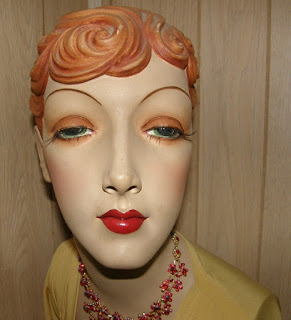Every art school used to have a huge collection of white plaster casts. Some still do. White allowed the student to see shadows more clearly and shadows are a lot of what pulls a composition together and suggests drama.
I'm writing this to suggest that we expand that collection a little bit to include a few colored mannequin heads. Mannequins don't have the same educational value as classical busts but the best ones are nice and cartoony and are often a good way to drive home a few basic lessons about what to emphasize on a face. What are those lessons? Read on.
Real women on the other hand, often had weak chins, and would probably have preferred to emphasize their eyes. That wasn't so easy to do. According to an article I read the older kinds of eye makeup had problems with dry spatter and required constant touch ups. More about eyes later.
Back to sharp chins. They show to best advantage when the head is tilted back. That reinforces the haughty, aristocratic image that fashion likes to convey.
Somewhere along the line a long, vertical mannequin faces were introduced. I think of it as a modified Asiatic look but you can find African masks that look a bit like that.
The sharp chin never went out of style, though. It got new life when it was combined with the forward-thrusting muzzle. Here the whole bottom half of the face is pushed out. It's a very cartoony look.
For a while bulbous foreheads were in. How that started I can't even guess.
The big game changer was the invention of non-spatter eye make-up. That changed everything. It allowed for an emphasis on the eyes rather than the chin and that led the mannequin makers to tilt the head down.
Thin faces give greater eye emphasis so the wall-eyed, wide-angle, thin look took over.
Mens mannequins were less influenced by beauty products. About the only major face product change in my lifetime was the use of shampoo to replace bar soap in the washing of mens' hair. Shampoo made straight hair possible and wavy hair models disappeared. Chin emphasis persisted, though.
We men also liked the ultra-manly J. C. Leyendecker look. Later came the Arnold Schwarzenegger look.
The Arnold look receded and the nice guy next door look (above) took over. That was followed by the Urban Hipster look, which is what we have now.
I'll end with the observation that the hippies were never represented in the mannequin world. They had disdain for fashion and the fashion world retaliated by snubbing them. Fascinating, eh?
I'll end with the observation that the hippies were never represented in the mannequin world. They had disdain for fashion and the fashion world retaliated by snubbing them. Fascinating, eh?







































